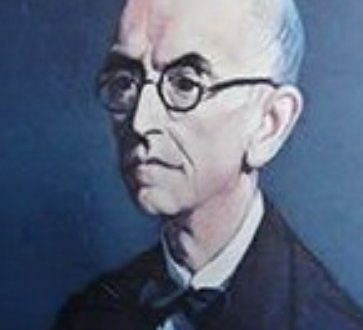
Mikalojus Konstantinas Čiurlionis |
Mikalojus Čiurlionis
Autumn. Naked garden. Half-naked trees rustle and cover the paths with leaves, and the sky gray-gray, and as sad as only the soul can be sad. M. K. Ciurlionis
The life of M. K. Chiurlionis was short, but creatively bright and eventful. He created ca. 300 paintings, ca. 350 pieces of music, mostly piano miniatures (240). He has several works for chamber ensembles, for choir, organ, but most of all Čiurlionis loved the orchestra, although he wrote little orchestral music: 2 symphonic poems “In the Forest” (1900), “Sea” (1907), overture “Kėstutis” ( 1902) (Kyastutis, the last prince of pre-Christian Lithuania, who became famous in the fight against the crusaders, died in 1382). Sketches of the “Lithuanian Pastoral Symphony”, sketches of the symphonic poem “The Creation of the World” have been preserved. (Currently, almost all of Čiurlionis’s legacy – paintings, graphics, autographs of musical works – is kept in his museum in Kaunas.) Čiurlionis lived in a bizarre fantasy world, which, in his words, “only intuition can tell.” He loved to be alone with nature: to see off the sunset, to wander through the forest at night, to go towards a thunderstorm. Listening to the music of nature, in his works he sought to convey its eternal beauty and harmony. The images of his works are conditional, the key to them is in the symbolism of folk legends, in that special fusion of fantasy and reality, which is characteristic of the people’s worldview. Folk art “should become the foundation of our art…” wrote Čiurlionis. “…Lithuanian music rests in folk songs… These songs are like blocks of precious marble and await only a genius who will be able to create immortal creations from them.” It was Lithuanian folk songs, legends and fairy tales that brought up the artist in Čiurlionis. From early childhood, they penetrated into his consciousness, became a particle of the soul, took a place next to the music of J. S. Bach, P. Tchaikovsky.
Čiurlionis’ first music teacher was his father, an organist. In 1889-93. Čiurlionis studied at the orchestral school of M. Oginsky (grandson of the composer M. K. Oginsky) in Plungė; in 1894-99 studied composition at the Warsaw Musical Institute under 3. Moscow; and in 1901-02 he improved at the Leipzig Conservatory under K. Reinecke. A man of diverse interests. Čiurlionis eagerly absorbed all musical impressions, enthusiastically studied art history, psychology, philosophy, astrology, physics, mathematics, geology, paleontology, etc. In his student notebooks there is a bizarre interweaving of sketches of musical compositions and mathematical formulas, drawings of a slice of the earth’s crust and poems.
After graduating from the conservatory, Čiurlionis lived in Warsaw for several years (1902-06), and here began painting, which more and more fascinated him. From now on, musical and artistic interests constantly intersect, determining the breadth and versatility of his educational activities in Warsaw, and since 1907 in Vilnius, Čiurlionis became one of the founders of the Lithuanian Art Society and the music section under it, led the Kankles choir, organized Lithuanian art exhibitions, music competitions , engaged in music publishing, streamlining Lithuanian musical terminology, participated in the work of the folklore commission, conducted concert activities as a choir conductor and pianist. And how many ideas failed to implement! He cherished thoughts about the Lithuanian music school and music library, about the National Palace in Vilnius. He also dreamed of traveling to distant countries, but his dreams came true only in part: in 1905 Čiurlionis visited the Caucasus, in 1906 he visited Prague, Vienna, Dresden, Nuremberg, and Munich. In 1908-09. Čiurlionis lived in St. Petersburg, where, since 1906, his paintings were repeatedly exhibited at exhibitions, arousing the admiration of A. Scriabin and the artists of the World of Art. The interest was mutual. The romantic symbolism of Čiurlionis, the cosmic cult of the elements – the sea, the sun, the motives of climbing to the shining peaks behind the soaring bird of Happiness – all this echoes the images-symbols of A. Scriabin, L. Andreev, M. Gorky, A. Blok. They are also brought together by the desire for a synthesis of the arts, characteristic of the era. In the work of Čiurlionis, a poetic, pictorial and musical embodiment of the idea often appears at the same time. So, in 1907, he completed the symphonic poem “The Sea”, and after it he wrote the piano cycle “The Sea” and the picturesque triptych “Sonata of the Sea” (1908). Along with piano sonatas and fugues, there are paintings “Sonata of the Stars”, “Sonata of Spring”, “Sonata of the Sun”, “Fugue”; poetic cycle “Autumn Sonata”. Their commonality is in the identity of images, in a subtle sense of color, in the desire to embody the ever-repeating and ever-changing rhythms of Nature – the great Universe generated by the imagination and thought of the artist: “… The wider the wings open wide, the more the circle goes around, the easier it will become, the happier it will be man…” (M. K. Ciurlionis). Čiurlionis’ life was very short. He died in the prime of his creative powers, on the threshold of universal recognition and glory, on the eve of his greatest accomplishments, not having had time to accomplish much of what he had planned. Like a meteor, his artistic gift flared up and went out, leaving us a unique, inimitable art, born of the imagination of an original creative nature; art that Romain Rolland called “an entirely new continent”. In it is a feeling of the infinity and grandeur of the Universe, in it is the struggle of powerful elements, overcoming which Man strives for the true, good, beautiful.
O. Averyanova





